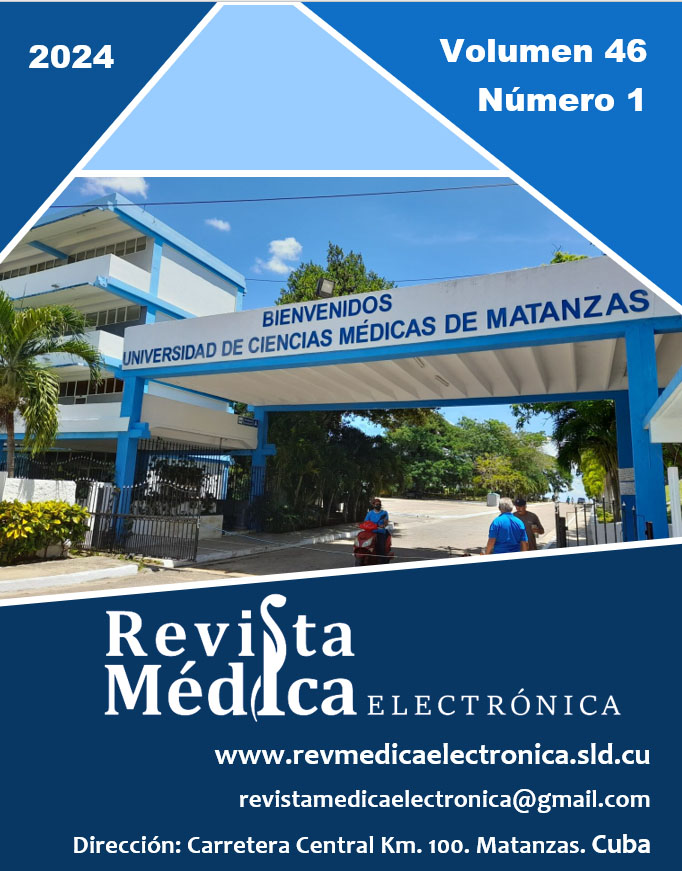Pedagogical strategy to prevent lower limb injuries in senior male volleyball players
Keywords:
pedagogical strategy, lower limb injuries, volleyballAbstract
Introduction: A pedagogical strategy to prevent injuries is defined as a structured set of methods, activities, and didactic resources designed to educate and train athletes in practices so that they minimize the risk of injury.
Objective: To evaluate the effectiveness of a pedagogical strategy designed to prevent injuries in the lower limb of male volleyball players of the senior category.
Methods: Explanatory descriptive research of longitudinal order. Injuries of lower limbs of volleyball players are studied for two years (2022-2024). A pedagogical strategy is implemented for a population of volleyball players identified in the city of Guayaquil (N=73), which consist of education and awareness actions, muscle strengthening and conditioning, specialized training in jumping and landing techniques, flexibility training, joint mobility, cooling down and recovery sessions, and use of preventive equipment.
Results: Improvements are observed in six indicators studied, including frequency of injuries (64.3%), muscle strength (31.4%), balance (46.4%); range of motion (13.7%), proprioception (64.1%), and injury recovery time (42.7%).
Conclusions: Notable improvements are evident in the prevention of lower limb injuries of volleyball players, once a pedagogical strategy has been implemented for two years. The improvements are demonstrated in the decrease of injuries frequency, in the increase of local muscle strength and one-leg balance, in the improvement of the range of joint movements and proprioception, as well as in the decrease of the time used for recovery from injuries.
Downloads
References
2. Young WK, Briner W, Dines DM. Epidemiology of common injuries in the volleyball athlete. Curr Rev Musculoskelet Med. 2023;16:229-34. DOI: 10.1007/s12178-023-09826-2.
3. Calero Morales S, Mena Pila FM. Estudio de las lesiones más comunes en el rugby ecuatoriano, categoría senior. Rev Cubana Inv Bioméd [Internet]. 2018 [citado 16/06/2024];37(4). Disponible en: http://www.revibiomedica.sld.cu/index.php/ibi/article/view/201
4. Verhagen E, Vriend I, Gouttebarge V, et al. Effectiveness of a warm-up programme to reduce injuries in youth volleyball players: a quasi-experiment. Br J Sports Med [Internet]. 2023 [citado 16/06/2024];57(8):464-70. Disponible en: https://bjsm.bmj.com/content/57/8/464
5. Molina-Martín JJ, Serrano CL, Morales S, et al. Volleyball ball design performance effects on service reception in high-level women. Retos. 2023;50:711-6. DOI: 10.47197/retos.v50.99540.
6. Calero Morales S, Fernández Lorenzo A, Chávez Cevallos E. Anomalies in effectiveness: A mathematical model used in international volleyball. Retos. 2017;32:194-8. DOI: 10.47197/retos.v0i32.49650.
7. Morán-Pedroso L, Chamorro-Balseca NC, Sánchez-Córdova B, et al. Análisis pedagógico de las adaptaciones cardiovasculares del equipo campeón universitario de voleibol masculino. Rev Méd Electrón [Internet]. 2024 [citado 16/08/2024];46. Disponible en: http://scielo.sld.cu/scielo.php?pid=S1684-18242024000100080&script=sci_arttext&tlng=pt
8. Calero-Morales S, Villavicencio-Alvarez VE, Flores-Abad E, et al. Pedagogical control scales of vertical jumping performance in untrained adolescents (13–16 years): research by strata. PeerJ. 2024;12:e17298. DOI: 10.7717/peerj.17298.
9. Calero-Morales S, Vinueza-Burgos GC, Yance-Carvajal CL, et al. Gross Motor Development in Preschoolers through Conductivist and Constructivist Physical Recreational Activities: Comparative Research. Sports [Internet]. 2023 [citado 16/08/2024];11(3):61. https://www.mdpi.com/2075-4663/11/3/61
10. Rostami A, Letafatkar A, Gokeler A, et al. The effects of instruction exercises on performance and kinetic factors associated with lower-extremity injury in landing after volleyball blocks. J Sport Rehabil. 2020;29(1):51-64. DOI: 10.1123/jsr.2018-0163.
11. Zarei M, Soltani Z, Hosseinzadeh M. Effect of a proprioceptive balance board training program on functional and neuromotor performance in volleyball players predisposed to musculoskeletal injuries. Sport Sci Health. 2022;18(3):975-82. DOI: 10.1007/s11332-021-00882-0.
12. Tee JC, McLaren SJ, Jones B. Sports injury prevention is complex: we need to invest in better processes, not singular solutions. Sports Med. 2020;50(4):689-702. DOI: 10.1007/s40279-019-01232-4.
13. Palmi J, Alcubierre N, Gil Moreno de Mora G, et al. 4BR: educational training Programme for the prevention of sports injuries in young athletes. Int J Environ Res Public Health. 2021;18(10):5487. DOI: 10.3390/ijerph18105487.
14. Wang Y, Jia Q, Deng T. The Effect of Ankle Joint Proprioception Training on Preventing Ankle Joint Injury of Athletes. Investigación Clínica [Internet]. 2020 [citado 16/06/2024];61(2). Disponible en: https://go.gale.com/ps/anonymous?id=GALE%7CA626504693&sid=googleScholar&v=2.1&it=r&linkaccess=abs&issn=05355133
15. Coves-García A, Lozano-Quijada C, Poveda-Pagán EJ. Estrategias para la prevención de lesiones de ligamento cruzado anterior en mujeres deportistas con valgo dinámico de rodilla. Revisión sistemática. Fisioterapia. 2023;45(5):273-89. DOI: 10.1016/j.ft.2023.04.002.
16. Zwierzchowska A, Gaweł E, Gómez MA, et al. Prediction of injuries, traumas and musculoskeletal pain in elite Olympic and Paralympic volleyball players. Sci Rep. 2023;13(1):11064. DOI: 10.1038/s41598-023-38112-x.
17. Fonseca ST, Souza TR, Verhagen E, et al. Sports injury forecasting and complexity: a synergetic approach. Sports Medicine. 2020;50(10):1757-70. DOI: 10.1007/s40279-020-01326-4.
18. Game Mendoza KM, Vinueza Burgos GdC, Icaza Rivera DP, et al. Efectos de las estrategias colaborativas en el proceso académico de enseñanza-aprendizaje de voleibolistas prejuveniles. Retos. 2024;61:1172-83. DOI: 10.47197/retos.v61.109363.
19. Heil J, Büsch D. Dynamic postural control and physical stress: an approach to determining injury risk in real sporting conditions. Ger J Exerc Sport Res. 2023;53(2):196-205. DOI: 10.1007/s12662-022-00833-y.
20. Sniras SA, Uspuriene AB, Malinauskas RK. Competencies of Physical Education Teachers for Injury Prevention. Eur J Contemp Educ. 2020;9(4):893-901. DOI: 10.13187/ejced.2020.4.893.
21. Paguay Balladares WJ, Morocho Ocaña GA, Pereira Salcedo JR, et al. Perfectivas de la comunicación en salud (información, instrucción e integración). Criterios en el entorno guayaquileño. Rev Cubana Inv Bioméd [Internet]. 2024 [citado 13/08/2024];43:e3208. Disponible en: http://scielo.sld.cu/pdf/ibi/v43/1561-3011-ibi-43-e3208.pdf
22. Crossley KM, Patterson BE, Culvenor AG, et al. Making football safer for women: a systematic review and meta-analysis of injury prevention programmes in 11 773 female football (soccer) players. Br J Sports Med [Internet]. 2020 [citado 13/08/2024];54(18):1089-98. Disponible en: https://bjsm.bmj.com/content/54/18/1089
23. Gomez Huichi M. Revisión descriptiva de la prevención de lesiones comunes en el voleibol. Rev latinoam Ogmios. 2022;2(3):85-94. DOI: 10.53595/rlo.v2.i3.025.
24. Gadea-Uribarri H, Lago-Fuentes C, Bores-Arce A, et al. External Load Evaluation in Elite Futsal: Influence of Match Results and Game Location with IMU Technology. J Funct Morphol Kinesiol. 2024;9. DOI: 10.20944/preprints202407.0538.v1.
25. Villanueva-Guerrero O, Gadea-Uribarri H, Villavicencio Álvarez VE, et al. Relationship between Interlimb Asymmetries and Performance Variables in Adolescent Tennis Players. Life. 2024;14(8):959. DOI: 10.3390/life14080959.
Downloads
Published
How to Cite
Issue
Section
License
All content published in this journal is Open Access, distributed under the terms of the CC BY-NC 4.0 License.
It allows:
- Copy and redistribute published material in any medium or format.
- Adapt the content.
This will be done under the following terms:
- Attribute the authors' credits and indicate whether changes were made, in which case it must be in a reasonable way.
- Non-commercial use.
- Recognize the journal where it is published.
The copyrights of each article are maintained, without restrictions.






